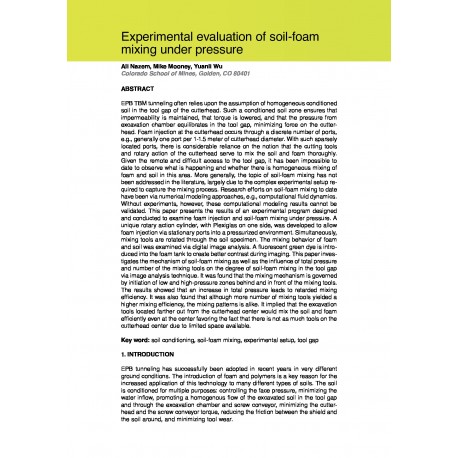Cart
0
0
No document
0,00 €
Total
Document successfully added to your shopping cart
Quantity
Total
There are 0 items in your cart.
There is 1 item in your cart.
Total documents
Total shipping
To be determined
Total
Search & filter
Search for a publication
Search & filter
Viewed documents

Experimental evaluation of soil-foam mixing under pressure
771_experimental_evaluation_of_s
EPB TBM tunneling often relies upon the assumption of homogeneous conditioned soil in the tool gap of the cutterhead. Such a conditioned soil zone ensures that impermeability is maintained, that torque is lowered, and that the pressure from excavation chamber equilibrates in the tool gap, minimizing force on the cutterhead. Foam injection at the cutterhead occurs through a discrete number of ports, e.g., generally one port per 1-1.5 meter of cutterhead diameter. With such sparsely located ports, there is considerable reliance on the notion that the cutting tools and rotary action of the cutterhead serve to mix the soil and foam thoroughly. Given the remote and difficult access to the tool gap, it has been impossible to date to observe what is happening and whether there is homogeneous mixing of foam and soil in this area. More generally, the topic of soil-foam mixing has not been addressed in the literature, largely due to the complex experimental setup required to capture the mixing process. Research efforts on soil-foam mixing to date have been via numerical modeling approaches, e.g., computational fluid dynamics. Without experiments, however, these computational modeling results cannot be validated. This paper presents the results of an experimental program designed and conducted to examine foam injection and soil-foam mixing under pressure. A unique rotary action cylinder, with Plexiglas on one side, was developed to allow foam injection via stationary ports into a pressurized environment. Simultaneously, mixing tools are rotated through the soil specimen. The mixing behavior of foam and soil was examined via digital image analysis. A fluorescent green dye is introduced into the foam tank to create better contrast during imaging. This paper investigates the mechanism of soil-foam mixing as well as the influence of total pressure and number of the mixing tools on the degree of soil-foam mixing in the tool gap via image analysis technique. It was found that the mixing mechanism is governed by initiation of low and high-pressure zones behind and in front of the mixing tools. The results showed that an increase in total pressure leads to retarded mixing efficiency. It was also found that although more number of mixing tools yielded a higher mixing efficiency, the mixing patterns is alike. It implied that the excavation tools located farther out from the cutterhead center would mix the soil and foam efficiently even at the center favoring the fact that there is not as much tools on the cutterhead center due to limited space available.


